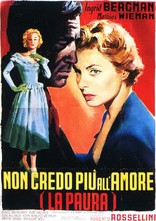本站提供 蓝光Blu-ray/HDTV 720P/1080P/2160P/4K 蓝光原盘 电影电视,硬盘代拷贝
代拷贝收费标准:例如:1TB硬盘(实际可拷贝930G)=100元,1.5TB硬盘(实际可拷贝1396GB)=150元,2TB硬盘(实际可拷贝1862GB)=200元,3TB硬盘(实际可拷贝2792GB)=300元。本站也有全新拷满自选片源硬盘出售。 网盘下载1G=0.2元,50G起。使用的网盘:115网盘 联系方式: 阿里旺旺:  淘宝店铺:http://94hd.taobao.com 淘宝店铺:http://94hd.taobao.com |
|
| ||
|---|---|---|
| 英文片名 | Fear | |
| 原始片名 | Non credo più all'amore (La paura) | |
| 中文片名 | 不安 (1954) | |
| 类型 | 剧情 | |
| 地区 | 意大利,西德,摩纳哥 | |
| 文件大小 | 36.42 GB, 蓝光原盘 1080p | |
| 备注 | DIY简繁中字 | |
| 文件格式 | BDMV/AVC | |
| 音轨 | 英语 LPCM 2.0 | |
| 字幕 | 简繁英 | |
| IMDB评分 | 6.6 | |
 ◎译 名 不安 / 恐惧 / Fear / Angst / La paura ◎片 名 Non credo più all'amore (La paura) ◎年 代 1954 ◎产 地 西德 / 意大利 ◎类 别 剧情 ◎语 言 德语 ◎上映日期 1954-11-05 ◎豆瓣链接 https://movie.douban.com/subject/1303574/ ◎片 长 Italy: 75 分钟 / USA: 84 分钟 / West Germany: 82 分钟 ◎导 演 罗伯托·罗西里尼 / Roberto Rossellini ◎演 员 英格丽·褒曼 / Ingrid Bergman 马蒂亚斯·维曼 / Mathias Wieman 雷娜特·曼哈特 / Renate Mannhardt 于尔根·米克施 / Jürgen Micksch 库尔特·克罗伊格 / Kurt Kreuger 埃莉泽·奥林格 / Elise Aulinger 克劳斯·金斯基 / Klaus Kinski 埃迪特·舒尔策-韦斯特鲁姆 / Edith Schultze-Westrum ◎编 剧 赛尔乔·阿米德伊 / Sergio Amidei 罗伯托·罗西里尼 / Roberto Rossellini 斯蒂芬·茨威格 / Stefan Zweig ◎制 片 人 赫尔曼·米拉科夫斯基 / Herman Millakowsky ◎音 乐 伦佐·罗西里尼 / Renzo Rossellini ◎摄 影 卡洛·卡利尼 / Carlo Carlini 海因茨·施纳克茨 / Heinz Schnackertz ◎剪 辑 瓦尔特·博斯 / Walter Boos ◎简 介 Whenever I see La Paura I think of it as a companion piece to Eyes Wide Shut, or maybe it is the other way around. Adultery makes both films tick but in different ways. I think Phillip French was right on the money when he pointed out a Wizard of Oz thing in Kubrick's last work. Like Dorothy, Tom and Nicole go through fantasies and nightmares and at the end Dorothy's reassuring childish motto "there's no place like home" is ironically updated to the adult circumstantial adage "there's no sex like marital sex". Kubrick's take is intellectual, he never leaves the world of ideas to touch the ground. He taunts the audience first with an erotic movie and then with a thriller and refuses to deliver either of them. He was married to his third wife for 40 years, until he died. Rossellini was still married to Ingrid Bergman when he directed La Paura; they had been adulterous lovers and their infidelity widely criticized La Paura is a tale, a noirish one. The noir intrigue is solved and the tale has a happy ending. The city is noir; the country is tale, the territory where childhood is possible. The transition is operated in the most regular way: by car, a long-held shot taken from the front of the car as it rides into the road, as if we were entering a different dimension. Irene (Bergman) starts the movie: we just see a dark city landscape but her voice-over narration tells us of her angst and informs us that the story is a flashback, hers. Bergman's been cheating on her husband. At first guilt is just psychological torture but soon expands into economic blackmail and then grows into something else. From beginning to end the movie focuses on what Bergman feels, every other character is there to make her feel something. Only when the director gives away the plot before the main character can find out does he want us to feel something Bergman still can't. When she finds out, we have already experienced the warped mechanics of the situation and we may focus once again on the emotional impact it has on Bergman's Irene. In La Paura treasons are not imagined but real, nightmares are deliberate and the couple's venom suppurates in bitter ways. Needless to say, Ingrid has another of her rough rides in the movies but Rossellini doesn't dare put her away as he did in Europa 51, nor does he abandon her to the inscrutable impassivity of nature (Stromboli). His gift is less transcendent and fragile than the conclusion of Viaggio in Italia. He just gives his wife as much of a fairy tale ending as a real woman can have, a human landscape where she can finally feel at home. Back to the country, a half lit interior scene where shadows suggest the comfort of sleep. After all, it's the "fairy godmother" who speaks the last words in the movie. | ||